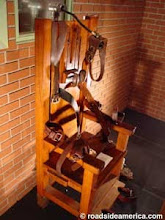It was shortly after midnight on the morning of February 8th, 1924 when Charles Reynolds walked into the room that housed the electric chair. He was strapped to the chair by guards and after three quick jolts of electricity he was pronounced dead. He and four others were put to death that morning, the first morning of the electric chair’s existence.[1] Over the next Forty-Eight years, three hundred and fifty-six others would be executed in the electric chair. In 1924, it was considered a humane way to execute someone, quicker and less painless than the hangings that took place before the chair was in use. But by the year 1972, the year that lethal injection took the place of the electric chair, it was thought of just as the hangings were. Cruel and Unusual punishment. The electric chair was always a source of controversy on whether or not it was a humane way to end someone’s life, but criticism grew throughout the twentieth century and protested against, until it was deemed an unfit way to execute someone, regardless of the crime they committed.
[1] Marquart, Ekland-Olsen, Sorensen,The Rope, The Chair, and The Needle: Capital Punishment in Texas, 1923-1990. 1st ed. Austin, TX: University of Texas Press, 1994

